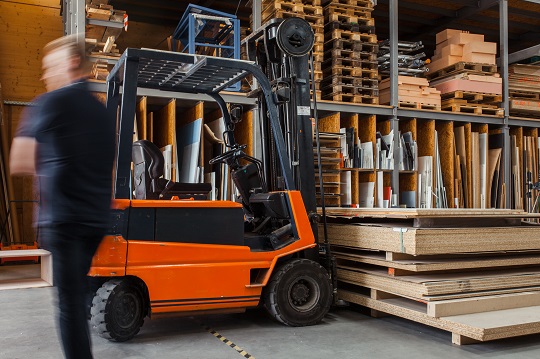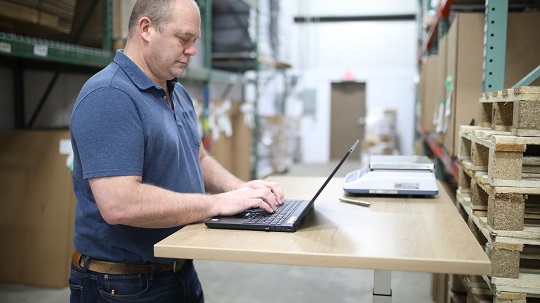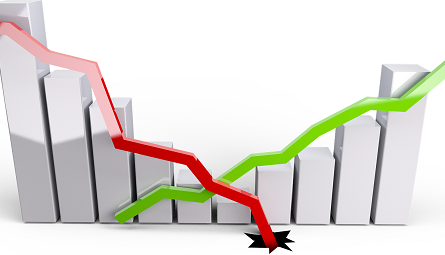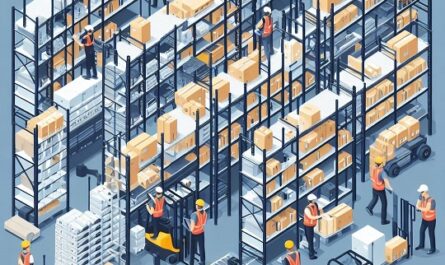As a business owner or manager, having a non-standard warehouse in terms of facilities, layout, and so on can indeed be a challenge.
Have you ever managed such a warehouse?
It may be challenging, but that doesn’t mean you can’t use the warehouse to its maximum potential.
In this post, we will discuss ideas and solutions on how to utilize a non-standard warehouse so that it can make a significant contribution to improving your business’s efficiency and profits.
But before that, make sure you have joined the scmguide telegram channel so you don’t miss the latest posts from this blog and get even more insights into supply chain management.
Table of Contents
Evaluating a non-standard warehouse
Before you start optimizing a non-standard warehouse, the first step you should take is to evaluate the facilities, layout, and other shortcomings.
This is important so that you can determine the potential and weaknesses of the non-standard warehouse, allowing you to design effective and efficient solutions.
So, what needs to be evaluated?
There are several factors that you need to evaluate, including:
- Warehouse size.
- Building condition and roof structure.
- Lighting and ventilation systems.
- Location and accessibility.
- Availability of electricity and water.
- Safety and security facilities.
In addition, you also need to evaluate the warehouse layout, such as the position of the entry and exit doors, rack positions, and material transportation routes.
After conducting an evaluation, the next step is to determine the potential and weaknesses of the non-standard warehouse.
This will be useful for you to understand the limitations of the warehouse and determine effective solutions that can be applied.
For example, if your warehouse is too small, you will need to place the items more efficiently.
Or perhaps your warehouse does not have adequate material transportation routes, so you need to redesign the warehouse layout to maximize its use.
Maximize the use of a non-standard warehouse
After conducting an evaluation and determining the potential and weaknesses of the non-standard warehouse, the next step is to maximize its use.
Here are some ways you can do this.
Identify business needs and suitability of available warehouse
The first step in maximizing the use of a non-standard warehouse is by identifying business needs and evaluating the suitability of the available warehouse.
Identifying business needs and the suitability of the available warehouse is an important step in maximizing the use of a non-standard warehouse.

The goal of this step is to determine whether the available warehouse is suitable for your business needs or not.
First, you need to identify your business needs by considering the type of goods that you will store in the warehouse, the frequency of shipments, and the storage time that you need.
For example, if your business is a food store, the items you store may include fresh food, packaged goods, and raw materials.
If you make daily deliveries, you may need a warehouse that is easily accessible and close to the delivery location.
In addition, if you store raw materials, you may need a warehouse that has temperature control facilities to maintain the quality of the goods.
After identifying your business needs, the next step is to evaluate the suitability of the available warehouse.
You need to check whether the available warehouse has the features and facilities required for your business.
For example, whether the warehouse has enough storage space for your goods, temperature control facilities, adequate security, easy access, and adequate transportation facilities.
If the available warehouse does not meet your business needs, then you need to look for another warehouse that is more suitable or renovate the available warehouse so that it can be used according to your needs.
Overall, by identifying your business needs and evaluating the suitability of the available warehouse, you can maximize the use of a non-standard warehouse more effectively.
You might also like:
- 8 Good Ways to Bring Down the Cost of Running a Warehouse
- Container Yard VS Warehouse for a Manufacturing Business: Which is More Profitable?
Planning efficient use and placement of goods
After identifying business needs and warehouse suitability, the next step is to plan for efficient use and placement of goods.
This can be done by considering factors such as the size and shape of the goods, the amount of inventory, and the appropriate storage system.

Planning for efficient use and placement of goods is an important step in maximizing the use of non-standard warehouses.
The goal of this step is to develop a strategy so that the goods stored in the warehouse can be arranged efficiently and easily found when needed.
First, you need to pay attention to the size and shape of the goods to be stored.
You need to consider the size and shape of the goods to determine the appropriate type of shelves or storage system.
For example, small items can be stored in shelving units with many drawers, while larger items such as machinery or vehicles may require specialized storage spaces.
Additionally, you also need to consider the weight of the goods so that the selected shelves or storage system can support them.
Second, the amount of inventory needs to be carefully calculated. You need to determine how many goods will be stored in the warehouse so that you can determine the size and number of shelves needed.
If you have a large inventory, you may need taller shelves or a larger warehouse.
Finally, you need to choose the appropriate storage system. The appropriate storage system will make it easier for you to access goods when needed and maximize available storage space.
Some storage systems that can be chosen include shelving units, automatic warehouse storage systems, and pallet storage systems.
By planning for efficient use and placement of goods, you can better maximize the use of non-standard warehouses.
By organizing goods efficiently, you can save storage space, increase productivity, and reduce storage costs.
Implementing an effective Warehouse Management System
An effective Warehouse Management System is crucial to maximizing the use of non-standard warehouses.
One way to improve warehouse management efficiency is by implementing inventory checking systems, monitoring shipments, and risk management.
Optimizing the use of the latest technology
Optimizing the use of the latest technology can also help you maximize the use of non-standard warehouses.
Some technologies that you can use include RFID, barcode scanning, and warehouse management software.
Renovation if possible
If possible, renovating the warehouse can also be done to maximize the use of the warehouse.
Renovation can include changes to the layout, addition of facilities, or improvement of the building structure to make it more efficient and safe.
By implementing the above strategies, the non-standard warehouse can be used to its maximum potential and will make a significant contribution to improving business efficiency and profitability.
Renovation of non-standard warehouses
On the other hand, if the evaluation you conduct indicates that renovation is necessary to maximize the use of the warehouse, the next step is certainly to consider renovation.
Determining the feasibility of renovation
However, before you carry out a renovation, it’s important to consider whether it’s feasible or not.
How?
You can do that by calculating the renovation costs, the time needed for renovation, and the potential profits you will get after renovation.
Determining the feasibility of a renovation is crucial before renovating a non-standard warehouse.

There are several factors that need to be considered in determining the feasibility of renovation, namely renovation costs, time needed for renovation, and potential profits after renovation.
First, you need to calculate the renovation costs that will be incurred. Renovation costs can include material costs, labor costs, and licensing fees.
You also need to consider additional costs that may arise during renovation such as the cost of temporary facilities or transportation costs.
Second, you need to consider the time needed to carry out the renovation.
Renovating a non-standard warehouse can take quite a long time depending on the level of damage or changes that need to be made.
You need to calculate the time needed to complete the renovation and its impact on warehouse operations.
Finally, you need to consider the potential profits after renovation. This can include improved operational efficiency, increased storage capacity, or improved quality of service offered to customers.
You need to carefully calculate whether the potential profits to be gained after renovation are large enough to cover renovation costs and provide sufficient benefits.
After considering these factors, you can decide whether the non-standard warehouse renovation is feasible or not.
If the renovation is feasible, you can start planning and implementing the renovation carefully to minimize risks and maximize desired results.
You might also like:
- What is a Warehouse, and Why is it Important in the Supply Chain?
- Your Warehouse is Full, do You Need to Make It Bigger, or Can You Do Something Else?
Planning the renovation
After determining the feasibility of renovating the non-standard warehouse, the next step is to plan the renovation with more detailed planning.
The renovation plan should include the repair of the building structure, improvement of the warehouse layout, replacement of the lighting system, improvement of the ventilation and cooling system, as well as improvement of the warehouse security.
Repairing the building structure
The first step in planning a renovation is to check the structure of the warehouse building and ensure that the building is safe and stable.
If there are any damaged or weak parts of the building, repairs should be made before the renovation begins.
Improvement of warehouse layout
After the building structure is repaired, it is necessary to consider the improvement of the warehouse layout.
You need to consider aspects such as the size and shape of the stored goods, the appropriate storage system, and space efficiency.
Replacement of lighting system
One important factor to consider in warehouse renovation is the lighting system.
You can replace the lighting system with a better one to ensure better visibility and help reduce the risk of accidents.
Improvement of ventilation and cooling system
The ventilation and cooling system also need to be repaired during the renovation.
This is important to maintain the appropriate temperature and humidity for the stored goods, as well as to maintain the quality of the air inside the warehouse to keep it healthy and safe.
Improvement of warehouse security
Lastly, it’s necessary to improve the warehouse security system.
This includes securing the building, installing a security alarm system, and monitoring the access in and out of the warehouse.
Warehouse security should be prioritized to ensure the safety and protection of stored goods.
By planning the renovation carefully, you can minimize risks and maximize desired results.
Be sure to involve experts or professional consultants in planning the renovation to obtain optimal results.
Conducting renovation at an affordable cost
In carrying out the renovation, of course, you also need to pay attention to the cost you will incur.
To minimize renovation costs, you can consider using inexpensive and time-saving materials, as well as utilizing available internal labor.
In addition, considering the impact of the renovation on ongoing warehouse operations can also help you minimize costs.
Ensuring safety and security during renovation
One important aspect of carrying out a renovation is ensuring safety and security during the renovation process.
Employees and contractors should be equipped with adequate safety gear, such as helmets, protective footwear, and respiratory protection, and should follow established safety protocols.
After the renovation is completed, the substandard warehouse can be upgraded into a more modern and efficient warehouse.
This can help improve efficiency in the supply chain and enhance your reputation.
Conclusion
A substandard warehouse can often be a challenge for you.
However, with careful evaluation and good planning, you can maximize its potential.
If renovation is possible and feasible, you can do it to improve warehouse efficiency and safety.
However, renovation also carries significant risks and costs.
Therefore, you need to consider it carefully before deciding to proceed.
Utilizing a substandard warehouse efficiently and effectively can help you improve business efficiency and maximize warehouse potential.
Do not hesitate to consider renovation if feasible, but make sure to plan carefully and pay attention to safety and related costs.
Hopefully, this information is useful! Share this article with your colleagues so that they can also benefit from it.
Join the scmguide telegram channel to receive notifications of the latest posts from this blog and more insights into supply chain management. All articles on this blog are free to use for any purpose, including commercial use, without the need for attribution.

 by
by 

